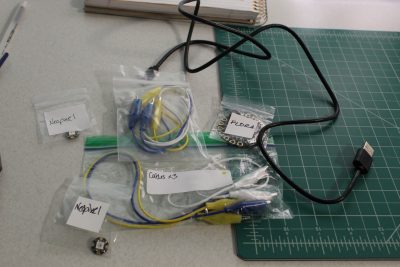 On Friday, March 1st, OPIM Innovate hosted its Wearable Tech in Action workshop from 1:00 PM to 3:00 PM in the Gladstein Lab. There, students were able to use hardware such as FLORA microcontrollers, UV light sensors, and force sensors to design their own wearable technologies with pre-coded software templates created using Arduino, an open-source electronic prototyping software. There were multiple projects students could choose from based on the parts they selected from the toolkit supplied by the event instructor. Encouraged to work on their own, students downloaded the Arduino software, began building their wearable technologies, and experimented with changing light colors and cycle times by altering the code provided to them on the workshop’s GitHub page.
On Friday, March 1st, OPIM Innovate hosted its Wearable Tech in Action workshop from 1:00 PM to 3:00 PM in the Gladstein Lab. There, students were able to use hardware such as FLORA microcontrollers, UV light sensors, and force sensors to design their own wearable technologies with pre-coded software templates created using Arduino, an open-source electronic prototyping software. There were multiple projects students could choose from based on the parts they selected from the toolkit supplied by the event instructor. Encouraged to work on their own, students downloaded the Arduino software, began building their wearable technologies, and experimented with changing light colors and cycle times by altering the code provided to them on the workshop’s GitHub page.
 Since this was the first time I had ever created a wearable piece of technology, I decided to build an accessory that utilized a FLORA microcontroller and a neopixel light. Thanks to the diagrams available to us when using the GitHub tutorials, it was not that difficult to put together. In all, it took one micro USB cord connected to my laptop to power the FLORA microcontroller and upload the Arduino code. From there, I had to use three alligator clips and three on-board pads, or points of contact between devices, on both the FLORA microcontroller and the neopixel light to individuate the electric pulses that would make the device work properly given the current code. Once everything was connected, the neopixel light began to cycle through different colors. At first, the device ran on a red, green, and blue cycle. Then I changed the colors to aqua blue, purple, and pastel pink.
Since this was the first time I had ever created a wearable piece of technology, I decided to build an accessory that utilized a FLORA microcontroller and a neopixel light. Thanks to the diagrams available to us when using the GitHub tutorials, it was not that difficult to put together. In all, it took one micro USB cord connected to my laptop to power the FLORA microcontroller and upload the Arduino code. From there, I had to use three alligator clips and three on-board pads, or points of contact between devices, on both the FLORA microcontroller and the neopixel light to individuate the electric pulses that would make the device work properly given the current code. Once everything was connected, the neopixel light began to cycle through different colors. At first, the device ran on a red, green, and blue cycle. Then I changed the colors to aqua blue, purple, and pastel pink.
 As I continued to experiment with my wearable accessory, I found that you could do various things with the code. For one, you could decrease the brightness of the lights, or even add an extra color to the current hue loop. Looking around me, I also saw my peers use Arduino to create color waves utilizing the neopixel strip, which carries 60 individual neopixels inside of it. Light traveled up and down the strip in a single color, something that could have become a rainbow arrangement with a little extra time.
As I continued to experiment with my wearable accessory, I found that you could do various things with the code. For one, you could decrease the brightness of the lights, or even add an extra color to the current hue loop. Looking around me, I also saw my peers use Arduino to create color waves utilizing the neopixel strip, which carries 60 individual neopixels inside of it. Light traveled up and down the strip in a single color, something that could have become a rainbow arrangement with a little extra time.
If you or someone you know is interested in wearable technology, consider visiting OPIM Innovate! We have wearable technology kits available for you to use at your own pace, and you do not have to be an expert to get started!
Thank you to everyone who attended the Wearable Tech workshop. We hope to see you again, soon!